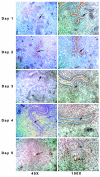The hamster as a model for embryo implantation: insights into a multifaceted process
- PMID: 18178492
- PMCID: PMC2288742
- DOI: 10.1016/j.semcdb.2007.11.001
The hamster as a model for embryo implantation: insights into a multifaceted process
Abstract
Defects in preimplantation embryonic development, uterine receptivity, and implantation are the leading cause of infertility, pregnancy problems and birth defects. Significant progress has been made in our basic understanding of these processes using the mouse model, where implantation is ovarian estrogen-dependent in the presence of progesterone. However, an animal model where implantation is progesterone-dependent must also be studied to gain a full understanding of the embryo and uterine events that are required for implantation. In this regard, the hamster is a useful model and this review summarizes the information currently available regarding mechanisms involved in synchronous preimplantation embryo and uterine development for implantation in this species.
Figures




Similar articles
-
Leukemia inhibitory factor ligand-receptor signaling is important for uterine receptivity and implantation in golden hamsters (Mesocricetus auratus).Reproduction. 2008 Jan;135(1):41-53. doi: 10.1530/REP-07-0013. Reproduction. 2008. PMID: 18159082
-
[Molecular regulatory network in embryo implantation].Sheng Li Ke Xue Jin Zhan. 2010 Dec;41(6):417-22. Sheng Li Ke Xue Jin Zhan. 2010. PMID: 21416958 Review. Chinese.
-
Novel pathways for implantation and establishment and maintenance of pregnancy in mammals.Mol Hum Reprod. 2010 Mar;16(3):135-52. doi: 10.1093/molehr/gap095. Epub 2009 Oct 30. Mol Hum Reprod. 2010. PMID: 19880575 Free PMC article. Review.
-
Uterine receptivity to human embryonic implantation: histology, biomarkers, and transcriptomics.Semin Cell Dev Biol. 2008 Apr;19(2):204-11. doi: 10.1016/j.semcdb.2007.10.008. Epub 2007 Oct 22. Semin Cell Dev Biol. 2008. PMID: 18035563 Free PMC article. Review.
-
Adherens junction proteins in the hamster uterus: their contributions to the success of implantation.Biol Reprod. 2011 Nov;85(5):996-1004. doi: 10.1095/biolreprod.110.090126. Epub 2011 Jul 13. Biol Reprod. 2011. PMID: 21753191 Free PMC article.
Cited by
-
Insight on Polyunsaturated Fatty Acids in Endometrial Receptivity.Biomolecules. 2021 Dec 27;12(1):36. doi: 10.3390/biom12010036. Biomolecules. 2021. PMID: 35053184 Free PMC article. Review.
-
Morphological, Ultrastructural, and Molecular Aspects of In Vitro Mouse Embryo Implantation on Human Endometrial Mesenchymal Stromal Cells in The Presence of Steroid Hormones as An Implantation Model.Cell J. 2018 Oct;20(3):369-376. doi: 10.22074/cellj.2018.5221. Epub 2018 May 15. Cell J. 2018. PMID: 29845791 Free PMC article.
-
Reliability of Rodent and Rabbit Models in Preeclampsia Research.Int J Mol Sci. 2022 Nov 18;23(22):14344. doi: 10.3390/ijms232214344. Int J Mol Sci. 2022. PMID: 36430816 Free PMC article. Review.
-
Cross-species transcriptomic approach reveals genes in hamster implantation sites.Reproduction. 2014 Dec;148(6):607-21. doi: 10.1530/REP-14-0388. Epub 2014 Sep 24. Reproduction. 2014. PMID: 25252651 Free PMC article.
-
Gene profiling the window of implantation: Microarray analyses from human and rodent models.J Reprod Health Med. 2016 Dec;2(Suppl 2):S19-S25. doi: 10.1016/j.jrhm.2016.11.006. Epub 2016 Dec 9. J Reprod Health Med. 2016. PMID: 28239559 Free PMC article.
References
-
- Trejo CA, Navarro MC, Ambriz GD, Rosado A. Effect of maternal age and parity on preimplantation embryo development and transport in the golden hamster (Mesocricetus auratus) Lab Anim. 2005;39:290–297. - PubMed
-
- Nagy A, Gertsenstein M, Vintersten K, Behringer R. Manipulating the mouse embryo. Cold Spring Harbor Laboratory Press; New York: 2003.
-
- Sheth B, Fesenko I, Collins JE, Moran B, Wild AE, Anderson JM, Fleming TP. Tight junction assembly during mouse blastocyst formation is regulated by late expression of ZO-1 alpha+ isoform. Development. 1997;124:2027–2037. - PubMed
-
- Gonzales DS, Bavister BD. Zona pellucida escape by hamster blastocysts in vitro is delayed and morphologically different compared with zona escape in vivo. Biol Reprod. 1995;52:470–480. - PubMed
Publication types
MeSH terms
Substances
Grants and funding
LinkOut - more resources
Full Text Sources
Other Literature Sources

